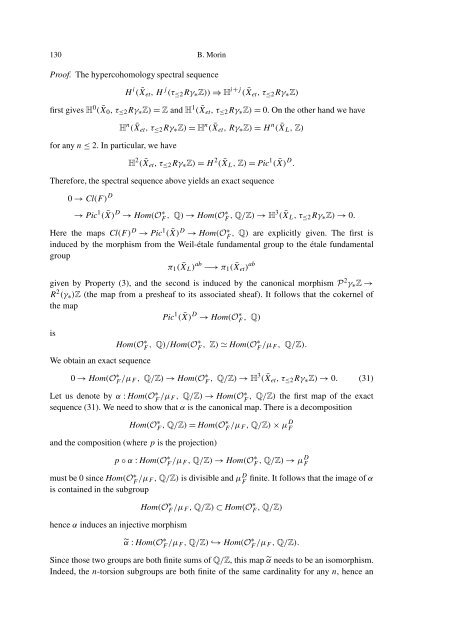THE WEIL-´ETALE FUNDAMENTAL GROUP OF A NUMBER FIELD I
THE WEIL-´ETALE FUNDAMENTAL GROUP OF A NUMBER FIELD I
THE WEIL-´ETALE FUNDAMENTAL GROUP OF A NUMBER FIELD I
You also want an ePaper? Increase the reach of your titles
YUMPU automatically turns print PDFs into web optimized ePapers that Google loves.
130 B. Morin<br />
Proof. The hypercohomology spectral sequence<br />
H i ( ¯X et ,H j (τ ≤2 Rγ ∗ Z)) ⇒ H i+j ( ¯X et ,τ ≤2 Rγ ∗ Z)<br />
first gives H 0 ( ¯X 0 ,τ ≤2 Rγ ∗ Z) = Z and H 1 ( ¯X et ,τ ≤2 Rγ ∗ Z) = 0. On the other hand we have<br />
for any n ≤ 2. In particular, we have<br />
H n ( ¯X et ,τ ≤2 Rγ ∗ Z) = H n ( ¯X et ,Rγ ∗ Z) = H n ( ¯X L , Z)<br />
H 2 ( ¯X et ,τ ≤2 Rγ ∗ Z) = H 2 ( ¯X L , Z) = Pic 1 ( ¯X) D .<br />
Therefore, the spectral sequence above yields an exact sequence<br />
0 → Cl(F ) D<br />
→ Pic 1 ( ¯X) D → Hom(O ∗ F , Q) → Hom(O∗ F , Q/Z) → H3 ( ¯X L ,τ ≤2 Rγ ∗ Z) → 0.<br />
Here the maps Cl(F ) D → Pic 1 ( ¯X) D → Hom(<strong>OF</strong> ∗ , Q) are explicitly given. The first is<br />
induced by the morphism from the Weil-étale fundamental group to the étale fundamental<br />
group<br />
π 1 ( ¯X L ) ab −→ π 1 ( ¯X et ) ab<br />
given by Property (3), and the second is induced by the canonical morphism P 2 γ ∗ Z →<br />
R 2 (γ ∗ )Z (the map from a presheaf to its associated sheaf). It follows that the cokernel of<br />
the map<br />
Pic 1 ( ¯X) D → Hom(O ∗ F , Q)<br />
is<br />
We obtain an exact sequence<br />
Hom(O ∗ F , Q)/Hom(O∗ F , Z) ≃ Hom(O∗ F /μ F , Q/Z).<br />
0 → Hom(O ∗ F /μ F , Q/Z) → Hom(O ∗ F , Q/Z) → H3 ( ¯X et ,τ ≤2 Rγ ∗ Z) → 0. (31)<br />
Let us denote by α : Hom(<strong>OF</strong> ∗ /μ F , Q/Z) → Hom(<strong>OF</strong> ∗ , Q/Z) the first map of the exact<br />
sequence (31). We need to show that α is the canonical map. There is a decomposition<br />
Hom(O ∗ F , Q/Z) = Hom(O∗ F /μ F , Q/Z) × μ D F<br />
and the composition (where p is the projection)<br />
p ◦ α : Hom(O ∗ F /μ F , Q/Z) → Hom(O ∗ F , Q/Z) → μD F<br />
must be 0 since Hom(<strong>OF</strong> ∗ /μ F , Q/Z) is divisible and μ D F<br />
is contained in the subgroup<br />
finite. It follows that the image of α<br />
hence α induces an injective morphism<br />
Hom(O ∗ F /μ F , Q/Z) ⊂ Hom(O ∗ F , Q/Z)<br />
˜α : Hom(O ∗ F /μ F , Q/Z)↩→ Hom(O ∗ F /μ F , Q/Z).<br />
Since those two groups are both finite sums of Q/Z,thismap˜α needstobeanisomorphism.<br />
Indeed, the n-torsion subgroups are both finite of the same cardinality for any n, hence an

















